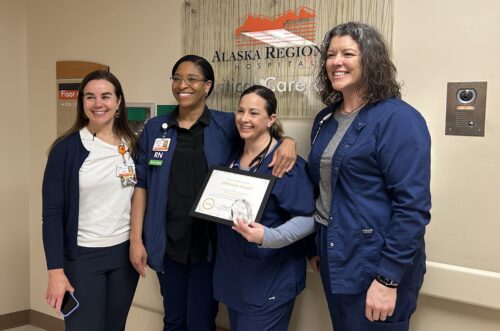The medical professionals we work with have a significant and direct influence on donation outcomes. Just as the geography and demographics of our vast service area differ from place to place, so does the donation experience. In an effort to celebrate the successes and highlight the unique obstacles of our donation partners, we interviewed leadership from around our region to ask why donation is important to them and what they enjoy most about living and working where they do. We are proud to feature Carol Bensen, Chief Nursing Officer at Providence St. Patrick Hospital as our February “Leader in Donation.”
Providence St. Patrick Hospital is a level two trauma center located in Missoula, Montana and is the leading organ and tissue donation hospital in Western Montana. In 2017, St. Patrick’s had six organ donors saving the lives of 22 people and had a donation rate of 86%, the highest in the entire LifeCenter region for hospitals classified as having the highest number of potential organ donors. We recently sat down with Carol to learn more about St. Patrick’s successful donation program.

What drives you to make donation a priority in your hospital?
It is providing that hope to families. To me, that really is my passion around it.
What does organ and tissue donation mean to you?
It means a lot to me. Working in emergency services for so long it’s been a focus in all of my nursing career. With all the cases we see, all the tragedies, this is the one hope that many families can walk away with. It’s being able to offer that hope.
Best Practice: Hospitals with successful donation programs have a commitment to donation at the highest levels of leadership.
What makes you most proud of working at St. Patrick’s?
The collaboration the team has with LifeCenter Northwest and has had for many years. The commitment really makes me proud.
The other thing I’m very proud of is some of our nurses have gone on to join the LCNW team, and they come back to manage organ donors. They know our systems, they know the staff, and the docs know them. They trust the decisions that they make, know their clinical expertise, and to me that creates a team environment even more effective than it would be if it wasn’t someone that we knew on a regular basis.
Best Practice: Collaboration between the hospital and LifeCenter Northwest is critical to the success of a donation program. Without communication and trust, the donation process will not function effectively.
Why has your donation program been so successful at St. Patrick Hospital?
It’s because of Dawn Rohrbach’s (ICU Clinical Nurse Manager) championship. She’s been in the ICU for so long that this truly is a calling for her. She really is the advocate for us.
Best Practice: Committed donation champions in key areas of the hospital help ensure the creation of strong processes and systems to support donation.
Also, LifeCenter’s commitment to us. Having support from your leadership team in the work that we do and recognition of that work, to me that collaboration over the years has been a key to success.
Best Practice: A leadership to leadership relationship is critical to a shared responsibility of a successful donation program.
What’s unique about healthcare in your region?
St. Pat’s is a tertiary care facility, a 200-bed hospital that provides pretty much everything but organ transplants. We are a facility that people rely on, especially in our rural community. I think that’s one of the things our health system doesn’t always recognize; the critical relationship we have with the rural community hospitals in the area.
The other area in which I think we are different is the fact that we are a level two trauma center. We have been a trauma center for 18 years. We are seen as experts within the state on treating trauma patients. Trauma and donation, unfortunately, go hand in hand a lot of times. We want to be the best at what we do, and we want to be able to provide the level of service that people expect.
Also, people work in Missoula because they want to, so we have a very high level of expertise for our specialists and our family practice and our internist, anesthesia, etc.
What do you love about living in Western Montana?
St. Pat’s offers anything that my 900 bed hospital offered in Minneapolis, except transplant. I was able to come to an organization that gave me a lot of opportunities over the last 12 years. From a professional perspective, I’ve had the opportunity for growth and support from my peers. While that has been something that I’ve had other places, to, kind of, end my career in an environment like this is really important to me.





